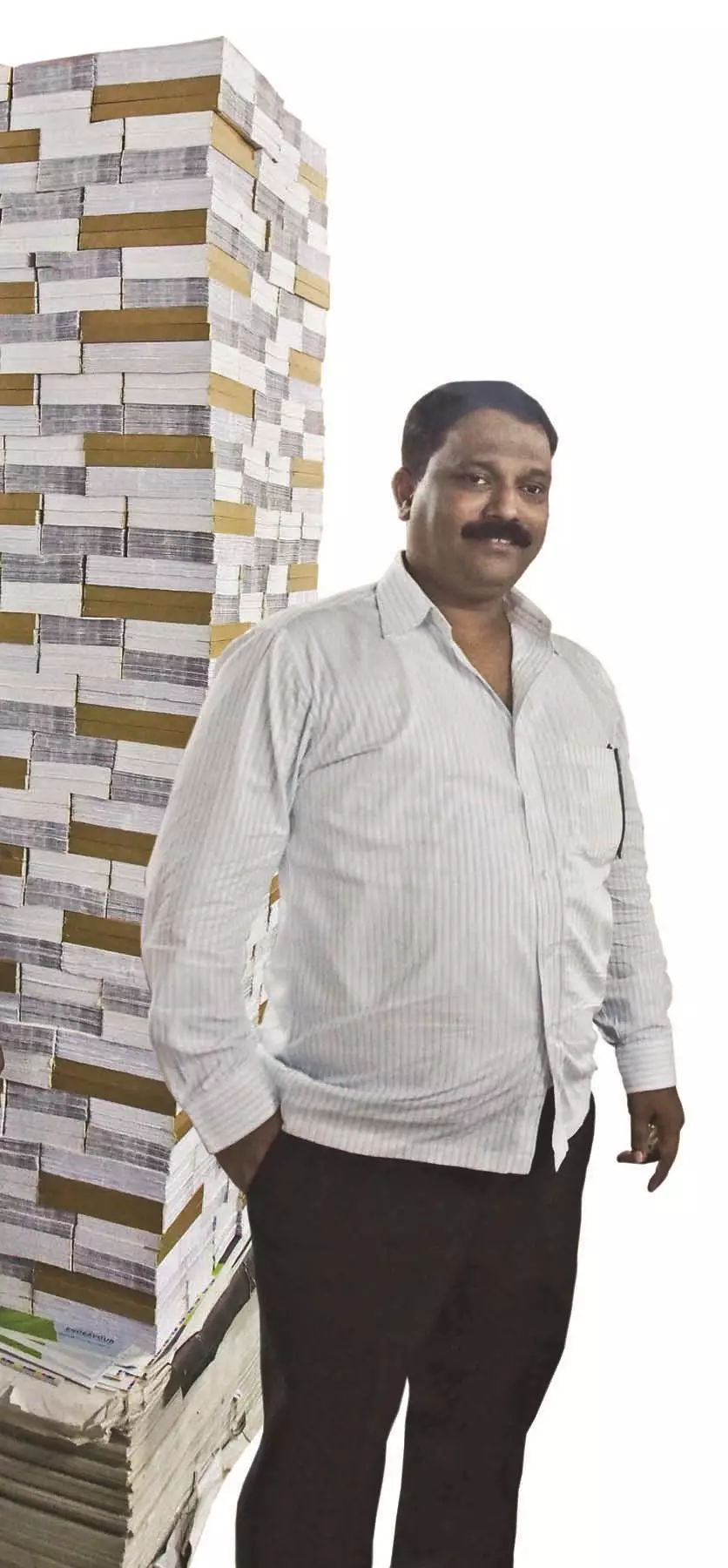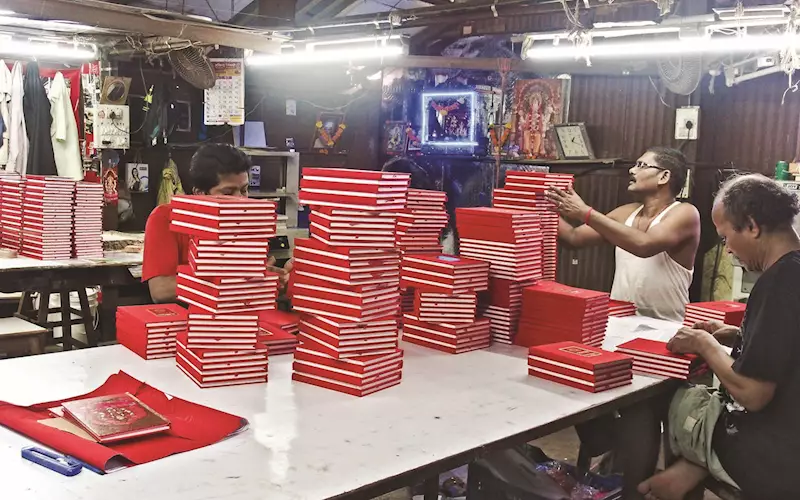Nitin Book Binding Works: The last of the binding Mohicans
Brand ‘Nitin Binding’ is synonymous with ‘complex binding made simple’. Nitin Kandar has survived the trend of print firms opting for in-house binding, which swept away trade finishers, discovers Rushikesh Aravkar.
30 Aug 2016 | By Rushikesh Aravkar
In 1993, when an 18-year old ITI-trained maintenance mechanic Nitin Kandar landed an apprenticeship with Bombay Oil, little did he know that three months into the probation, he would be forced to take a leave of absence to care for his ailing father. And the family’s small bindery with its seven staffers became Nitin’s responsibility.
When Kandar took over the reins of the business, the six-year-old firm used to rebind old library books and produced small textbook pinning jobs for a couple of print firms.

“I was young with a throbbing desire,” says Kandar. “I kicked my heels up, knocking at every printer’s door, to add business.” After two weeks of heavy-duty sales efforts, this rookie binder was entrusted with a job for section sewing 10,000 copies of a religious book.
“It was Spectrum Graphics that allowed us this big job. It was an opportunity to make a difference and the entire team was brimming with enthusiasm to deliver something that is best in class. One big job led to another.”
This led to creation of brand Nitin Binding as an established binding house with bona fide credentials and knowledge.
By 1994, Kandar overhauled his binding unit and added a Polar programmable cutting machine and that “was the turning point”. “It brought us speed and control on our quality,” he adds.
It was a time when trade binders had started turning into printers, undertaking high volume jobs like textbooks. P Sajith of Welbound Worldwide, whose machines were at the heart of a binding revolution in the country, says, “There was a trade off between being a small or medium-sized niche player and becoming a volume player. Some of them succeeded in this transformation, but many failed.”
The next decade saw the printers setting up in house binderies and that saw some of the trade binders shutting shop.
Sajith observes, “Nitin Binding, decided not to follow the trend. It improved its skills and offerings, be it high quality hard cover binding, ornamental binding, and also undertook jobs like specialty brochures and complex catalogues. It invested in its core strength and became a solution provider such that the printers with in-house binding capabilities also chased him for special jobs.”
Nitin probably understood that finishing is the final word in print and did not get lured by the so called status upgrade to a printer. And so, today, this specialised binder employs 300+ people at three locations, producing over 35,000 spines and 15,000 hard cases every day.
It epitomises that being big and being niche aren’t mutually exclusive. Specialisation, not size, is its badge of honour.
An ace binder
Next year, Nitin Binding will celebrate its 30th birthday. The company was founded in 1987 as a trade finisher in Mumbai. Over three decades, Nitin Binding went from being a small shop doing re-binding works to become a multi-locational specialist binding company, which also manages binding houses at the locations of master printers like Mumbai-based Silverpoint Press and Surat-based Progressive Printing Press.
According to Kandar, Mumbai-based SAP Print Solutions’ Sanjay Bamne taught him the economics and technical aspects of the business, while Jak Printers’ Khushru Patel was his quality guru. Kandar humbly says, “I learnt how to harness machines for maximum output from Mr Bamne, and Mr Patel’s insistence for quality made me go that extra mile to produce the best.”
The trade finishing firm has earned a reputation for making complex binding simple. Case binding is his USP. Kandar is keen to champion the cause of the final piece of the print puzzle, claiming that he wants to “bring finishing to the fore”.
What makes him different from others in this trade is his scientific approach to binding. Kandar is a self-taught binder who exactly knows the size of needle to be used for the given sheet of paper and which adhesive is fit for the particular purpose and many such tricks of the trade. That’s what makes him premium among the lot.
“People may look around and find something that seems cheaper,” he says. “We take responsibility for the entire job. And with our experience, we can tell the printer how best to print it so we can provide the best quality,” says Kandar.
Kandar adds, “What most print firms ignore is that although binding is a post-press function, binding considerations need to be dealt with in the pre-press phase of any print job.”
That’s why Nitin Binding gets involved right from the planning stage to consult the print firm on several parameters such as setting the right gauge grippers for printing considering the parameters for the folding machines, selecting the right paper grain depending on the job size and orientation, grain direction of board to avoid warping, using collating marks etc.
“The paper grammage and folding endurance of a paper will affect how many times a sheet can be folded. The Bible paper may need special equipment in order to fold and bind the sheets without damaging them. The paper’s grain direction also affects the ease with which finishing operations can be performed.”
What makes Nitin Binding stand apart is his no-compromise approach to the quality of raw materials and process. “I spend a lot of time with raw material suppliers. For example, in the case of hotmelt adhesives, we worked with several vendors and zeroed in on Henkel as we observed the consistency in their supplies. Also, I work with Welbound engineers, who partner with Henkel in India, when they introduce new products. I try and understand how different grades perform and then select the right ones for my application.”
Men over machines
In 1994, the firm invested in a secondhand Polar programmable cutting machine, his first high-end investment, when it was a rarity even among print firms and that Kandar says was the turning point for this small-time binder. “It brought us speed and control on our quality,” he adds.
Since then, Nitin Binding has been adding equipment. It has steadily and organically expanded over its lifetime. From 12 galas in Mumbai’s Bussa Industrial Estate, to managing Silverpoint’s Mahape bindery in a 25,000 sq/ft consolidated space was an eye-opener for Kandar. “Operating from 12 galas was a logistical nightmare that we didn’t realise until we experienced the ease of workflow at Silverpoint’s binding-under-one-roof shopfloor.” As a result, four years ago, Nitin Binding shifted its 12-gala operations to a 20,000 sq/ft unit in Sewri.
Today, it operates three units: Sewri, Silverpoint in Mahape and Progressive in Surat. At Sewri, it deploys three Polygraph sewing machines, three Stahl folders, two Welbound single-clamp perfect binding machines, and three cutting machine. Against the impressive post-press arsenal, the craft of hand-binding is alive and well.
The 10,000 sq/ft Surat unit dedicatedly produces hard case binding jobs for the textile industry, while at Silverpoint’s Mahape unit, Nitin Binding has deployed 125 people for the print firms captive usage.
With a touch of pride, Kandar also points out that Nitin Binding produces the top-notch case binding in the country.
But it’s not the equipment that this specialised firm derives its strength from, it’s the men at Nitin Binding that matter. These are the men with a keen eye for book finishing.
“People are the glue that holds us together,” says Kandar. “We won’t claim to be ‘leading-edge’ in terms of investment, we do have top notch machines, but, more importantly, for us, it’s about the skills, it’s about the experience, it’s about the knowledge, it’s about the people that have a depth of industry experience. The key for us over the years has been to develop and retain skilled workforce.”
Versatility is the key
Nitin Binding’s clientele itself speaks of his quality. From Silverpoint and Jak to Kaleidographics and Akruti.
Kandar recalls the most challenging job he bound about 12 years ago was a 12kg book. The print run of this 624-page book was close to 6,000 copies. “It was a Raymond’s job and the printing contract was accepted by one Rajendra Kotian of Veekay Printers. There was a lot of peer pressure for not accepting this job since it seemed an impossible proposition by most standards. But, we accepted the challenge and delivered it on time in full.”
In one other instance, when Rajat brand of notebooks and diaries, which was synonymous with quality in the sixties and the seventies, decided to outsource its production, it found in Nitin Binding the quality deliverables to be a perfect fit to maintain its brand image. Thus being instrumental in the revival of Rajat brand.
“We offer such an expansive range of services, I would argue we are the most versatile finisher in the country, but people just see us as being whatever we do for them. We have added so many new strings to our bow in recent years, we want to be the first place people go for all their finishing.”
Its service bouquet includes lamination, pinning, wiro-binding, hard case, back-to-back pasting and long line of services that the company has added over the 30 years.
A couple of years ago, Kandar partnered with his partner Abhijit Shetty to establish a sister concern United Reprographics which deploys a Komori Lithrone 28 four-colour printing machine and a two-colour Heidelberg printing machine. “This investment was in no way meant to compete with my existing clients rather we cater to our existing clients by printing their excess work. With this we also attract extra run-off-the-mill book work.”
Last year, the company has spent Rs 30-lakh adding a rigid box making line, thus making its venture into packaging, like every other print service provider aspires to do these days.
Nitin Binding’s book volumes has taken a toll and rigid box line is an affirmative step for the future. Although, Kandar is optimistic when he says, books are here to stay. He is excited about his next project – a binding unit in Pune with the support of Akruti Offset, which will go live in the next couple of months.











 See All
See All